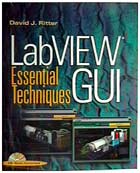 |
General Information__ |
|
|
LabVIEW GUI - Essential Techniques
by David J. Ritter The first GUI book written by LabVIEW programmers
|
||
| When friends, colleagues, customers, your boss - and most importantly, end-users - peer into your LabVIEW GUIs, what do they see? Sure, below the surface your LabVIEW application efficiently does everything it is supposed to do, but how much time and effort do you typically devote to making your GUI easy to use and pleasing to the eye?
Many LabVIEW programmers assign a relatively low priority to the user interface and devote very little attention to the usability and aesthetics of their applications. This is unfortunate because the GUI is the only part of the application end-user will ever see. Meticulous attention to detail while wiring the diagrams can be undermined completely if users are unable to pilot the GUI effectively. Designing a usable, visually-pleasing GUI is somewhat more difficult than it first appears. Unless we are designing the VI for our own personal use, we must ensure the GUI is clearly articulated so others can understand our intent. Because we have a comprehensive view of all aspects of the application goals, as well as the steps we have taken to meet the programming challenges, it is extremely difficult to view our GUIs objectively - through the eyes of end-users. Without this objectivity, the operation of our user interfaces may totally confound end-users. Most programmers will state that their GUIs are "intuitive". However, the true test of usability comes when the finished application is put in front of unsuspecting users. Only then will you uncover the shortcomings of your design. |
||
"LabVIEW GUI - Essential Techniques" examines all aspects of GUI design and programming within the context of the LabVIEW environment. Beginning with GUI psychology and fundamental GUI design principles, all aspects of GUI design and programming are explored. Key topics of discussion include:
In addition, a chapter entitled "The GUI Facelift" combines many of the theories and techniques introduced throughout the book into one practical, real-world example. In "A Brief History of Human Computer Interaction Technology", Brad A. Myers predicts that "user interfaces are likely to be one of the main value-added competitive advantages of the future, as both hardware and basic software become commodities." This book is designed to help you prepare for this future by fostering a deeper understanding of the motivations for - and the relative impact of - various GUI design choices. By combining numerous practical examples along with entire chapters devoted to GUI concepts and foundations, this book will help you become better prepared for change in the fast-paced world of technical software design |
||
| Preview Chapter 1 (.PDF file - Acrobat Reader required) | ||
| View the Table of Contents | ||
|
|
|
|
| LV GUI - Main Page | ||
| LV GUI - Support Pages | ||
|
|
||
BetterVIEW Homepage |
||
|
|
||